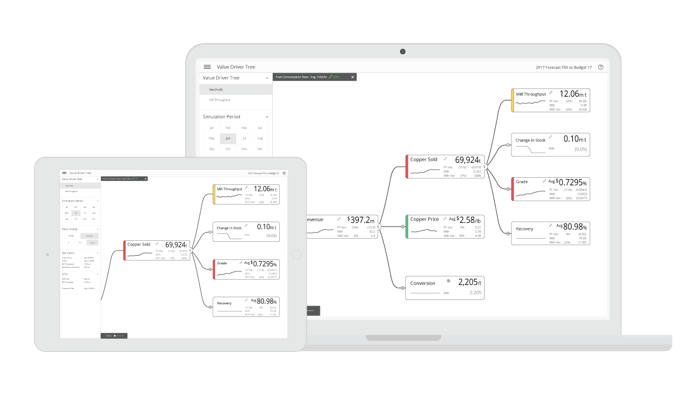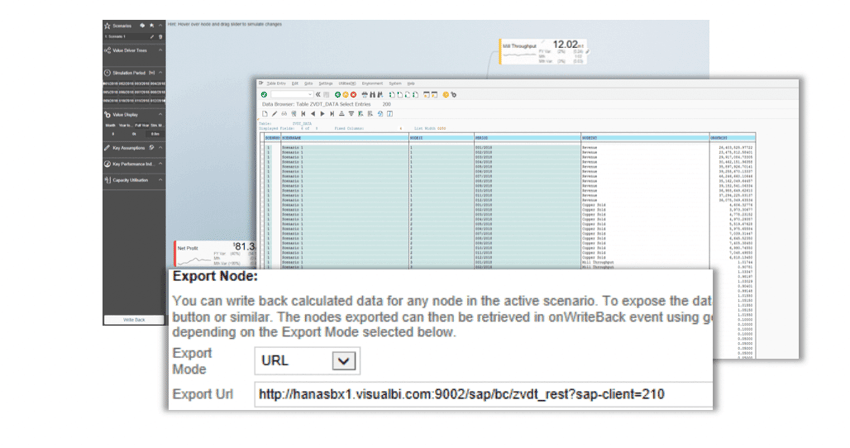At its most basic form, a Value Driver Tree is just a visual representation of a business model, with a mathematical or a logical relationship mapping the key business performance indicators (KPI’s) and the operational drivers driving the business. When coming up with a Value Driver Tree model for a business, one of the key aspects of success is the ability to use the model as a tool for planning and forecasting using simulations made on the tree.
The concept of planning or simulation is not something new – this is something that businesses have been doing for ages now. However, most businesses follow one or more traditional approaches:
Spreadsheet-based Planning
This is traditional, but a more ad-hoc approach to planning within an organization. This type of planning uses more conventional tools such as Microsoft Excel with formulas and macros to run different planning scenarios. Typically, in this type of a model, analysts extract data from existing forecasting or budgeting systems for planning. While this approach does allow ease-of-use for end users, it has a few shortcomings of its own:
- When the business model scales up, the number of parameters required will increase, making it complex and clunky.
- Data on the spreadsheet is usually extracted, making it static for a point in time. Planning on real-time data may not be possible.
- Sharing the model becomes difficult with other users.
With the traditional spreadsheet model, as the complexity goes up, it becomes more and more personalized for the analyst who created the model, making it difficult to maintain common planning scenarios within the business.
Bottom-up Planning Tools
Enterprise-based approaches usually involve the use of bottom-up planning tools such as SAP BPC,
SAP BW Integrated Planning etc. These tools are quite robust for enterprise-wide planning and what-if scenarios. However, they come with their own drawbacks, such as:
- Dependence on the IT department
- On-the-fly" simulations not easily possible
With the bottom-up planning tool approach, the process is either too slow or too complex. Therefore users quickly adopt spreadsheets to run ad-hoc analyses. As a result, this ends up becoming a hybrid approach over time where there is a mix of bottom-up planning and spreadsheet-based planning.
Can Visual BI’s ValQ help with these drawbacks?
Apart from the gaps mentioned above, one common gap for both traditional approaches to planning is that they both lack the capability to represent the planning model visually. It becomes easier for end users to comprehend and plan based on a business model when the relationship between different drivers and KPIs can be represented visually.
 Visual BI’s ValQ has the capability to visually represent these relationships in a tree structure while also offering plenty of options for analysts to map cross-dependent relationships in the model. Here are more ways that ValQ can address the gaps discussed above:
Visual BI’s ValQ has the capability to visually represent these relationships in a tree structure while also offering plenty of options for analysts to map cross-dependent relationships in the model. Here are more ways that ValQ can address the gaps discussed above:
- Model Complexity, Scaling and Performance
ValQ has a simple configuration technique that can be done directly within the tool, using a configuration spreadsheet or directly from a data source such as a BW Query or a HANA View. An in built JavaScript engine ensures that all calculations and simulations are executed almost instantly on the front-end, avoiding a back-end round trip. - Dynamic Models and Data Integration
The component offers the ability to connect to live Data Sources such as BW Queries or HANA Views. Single Data Sources can be connected directly, while multiple data sources can be merged using an added component. Tree Structures can also be derived directly from a Data Source. - Sharing ValQ Models between Users
Any application created for ValQ can be published on to the BusinessObjects platform and shared with other users easily. Since Data Sources can be used to drive the tree, a single version of the truth can also be ensured. - Requirement for Specialized Knowledge
Configuring ValQ can be done easily using intuitive options as part of the component or using a configuration spreadsheet. Once configured, using the tree as options at runtime are also very intuitive. - Requirement for Excessive Maintenance
Being a component that runs on SAP and Microsoft Power BI, Visual BI’s ValQ can be easily modified using the options available in the tool, or even completely re-configured almost instantly using a configuration spreadsheet. There is no requirement for planning functions or sequences to implement or scale up planning and what-if scenarios.
Does ValQ replace my traditional planning models?
While ValQ can be used as a standalone tool for planning, it does not have to necessarily replace your existing approaches altogether – ValQ can be used to complement the existing bottom-up planning tools being used.
ValQ has the capability to read data from SAP BW systems through SAP Lumira Designer. But in addition, it can also be used to write data back into a BW system using a RESTful web service and ABAP scripts, for instance. The tool comes with the ability to call these RESTful services for a write-back to write data back into, say, a planning cube that is being used for BW-IP.

ValQ or Traditional Planning Approaches?
ValQ is also available for Microsoft Power BI. ValQ as a tool can deliver an efficient planning and forecasting application which is quick, intuitive and agile. It can run simulations and calculations almost instantaneously and is mobile capable as well. However, thanks to the capabilities to leverage existing data sources, as well as the ability to leverage modules to write data back to these data sources, it becomes a robust tool that complements existing planning solutions.
This text was provided by our partner Visual BI

/Logo%202023%20final%20dunkelgrau.png?width=221&height=97&name=Logo%202023%20final%20dunkelgrau.png)























/HP_Hintergrundbild-01-06-2023_paralax-scrolling-Kreis-dunkel_klein.png)
